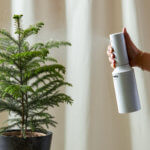Watering
Dry crispy leaves can be a sign your caladium is too dry. Water when the top 25% of soil is dry while the plant is putting out new growth. Water thoroughly and discard any excess water. If you find the soil is bone dry, a good soak is in order.
1. Fill a sink or tub with 2″-4″ of water, depending on the size of your plant.
2. Set the plant in the water without the saucer to allow it to soak the water from the bottom. Let the plant sit in the water for at least 30 minutes.
3. After the 30 minutes is up, feel the top of the soil to see if it has soaked up enough water. If it needs a little more time, let it sit for an additional 15-30 minutes, or water slightly from the top of the soil.
4. Drain the sink and let the plant rest and allow the water to trickle from the bottom.
6. Place plant back on saucer making sure there is no standing water.
Light
While these plants need bright indirect light when grown indoors, too much direct sun will scorch the leaves. Oftentimes the bright colors on the leaves will start to fade or appear washed out. Bright indirect light can be found in places close to an east-facing window or a few feet back from an unobstructed southern or western window. If the southern or western window has something like a sheer curtain or natural shade from a tree or building outside, the plant can be placed a little closer. Pruning off any heavily scorched leaves and placing it in a shadier spot will help.
Humidity
These tropical plants need lots of humidity. If the air is too dry, the leaves will start to turn a crispy brown on the edges. Mist often, add a pebble tray, or place a humidifier nearby.
Fertilizer
Caladium prefers to be fertilized once a month during spring and summer. Too much fertilizer or fertilizer applied to dry soil can burn the roots resulting in yellow and brown leaves. If over-fertilization is suspected you can flush the soil. Bring your plant to the sink or tub, depending on its size. Slowly pour water onto the top of the soil until you see it flowing freely through the drainage hole. Use approximately four times the pot’s volume in water to flush the soil. For example, use 1 gallon of water for a 1-quart pot.










